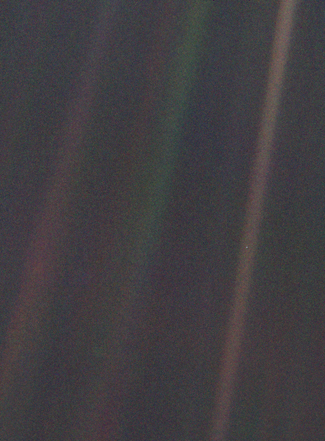Bledě modrá tečka

Bledě modrá tečka (v angličtině Pale Blue Dot) je fotografie planety Země, kterou v roce 1990 pořídila sonda Voyager 1 ze vzdálenosti 3,7 miliard mil (40,5 AU).[1]
Po ukončení mise sondy Voyager 1 u vnějších planet se sonda vydala na cestu ze sluneční soustavy. Americký astronom Carl Sagan přišel s myšlenkou využít kamery sondy k pořízení fotografie sluneční soustavy z jejího okraje za drahou Neptunu. NASA jeho myšlence vyhověla a před vypnutím kamer z Jet Propulsion Laboratory zadala sondě příkazy, které natočily kamery zpět do sluneční soustavy.
Později Carl Sagan název fotografie použil v titulu své knihy z roku 1994 Pale Blue Dot: A Vision of the Human Future in Space.[2]
Fotografie
Sonda Voyager 1 byla vypuštěna 5. září 1977, před ukončením mise ve Sluneční soustavě Carl Sagan přišel s myšlenkou, pořídit fotografie sluneční soustavy, včetně Země ve chvíli, kdy bude sonda za dráhou planety Neptun.[3][4][5][6] Dne 14. února 1990 po dokončení prvotních cílů byl z Jet Propulsion Laboratory odeslan sondě příkaz k otočení kamer zpět do sluneční soustavy a pořízení série fotografií jejích planet.[5][6][7][8] Mezi 14. únorem a 6. červnem 1990 poslala sonda Voyager 1 šedesát fotografií, které zobrazovaly všechny planety sluneční soustavy, mezi fotografiemi byla i Bledě modrá tečka.[3][9][10]
Vzdálenost sondy Voyager 1 od Země v době pořízení fotografie byla 3,7 miliard mil,[1] podle webové aplikace Jet Propulsion Laboratory jsou vzdálenosti následující:[11]
| Jednotky | 14. února 1990 | 6. června 1990 |
|---|---|---|
| Astronomické jednotky | 40,4722269111071 | 40,6835761263791 |
| Kilometry | 6 054 558 968 | 6 086 176 360 |
Fotografie byla pořízena přes modrý, zelený a fialový optický filtr.[12] Světelný pruh přes Zemi způsobilo slunečnímu záření, úhel mezi Zemí a Sluncem byl velmi malý.[6][9] Země zabírá na fotografii méně než jeden pixel – podle NASA „jen 0,12 pixelu.“[12]
Odkazy
Reference
V tomto článku byl použit překlad textu z článku Pale Blue Dot na anglické Wikipedii.
- ↑ a b Nasa image shows it's a wonderful world. The Independent [online]. 2010-03-03. Dostupné online. (anglicky)
- ↑ SAGAN, Carl. Pale Blue Dot: A Vision of the Human Future in Space. 1st edition. vyd. New York: Random House, 1994. ISBN 0-679-43841-6. (anglicky)
- ↑ a b SAGAN. Pale Blue Dot. [s.l.]: [s.n.] Dostupné v archivu pořízeném dne 2006-09-03. Kapitola Chapter 1. You Are Here. (anglicky) Archivovaná kopie. www.planetary.org [online]. [cit. 2011-05-04]. Dostupné v archivu pořízeném z originálu. The quote is much copied elsewhere on the web.
- ↑ SAGAN, Carl, Freeman J. Dyson, Jerome Agel. Carl Sagan's Cosmic Connection: An Extraterrestrial Perspective. [s.l.]: Cambridge University Press, 2000. ISBN 0521783038, ISBN 9780521783033. S. 302. (anglicky)
- ↑ a b BENNETT, Jeffrey O. Beyond UFOs: The Search for Extraterrestrial Life and Its Astonishing Implications for Our Future. [s.l.]: Princeton University Press, 2008. ISBN 0691135495, ISBN 9780691135496. S. 211. (anglicky)
- ↑ a b c VON BAEYER, Hans Christian. Taming the Atom: The Emergence of the Visible Microworld. [s.l.]: Courier Dover Publications, 2000. ISBN 0486414477, ISBN 9780486414478. S. 268. (anglicky)
- ↑ Pale Blue Dot [online]. The Planetary Society [cit. 2006-07-27]. Dostupné v archivu pořízeném dne 2007-09-27. (anglicky)
- ↑ COCKELL, Charles. Impossible Extinction: Natural Catastrophes and the Supremacy of the Microbial World. [s.l.]: Cambridge University Press, 2003. ISBN 0521817366, ISBN 9780521817363. S. 181. (anglicky)
- ↑ a b GONZALEZ, Guillermo, Jay Wesley Richards. The Privileged Planet: How Our Place in the Cosmos is Designed for Discovery. [s.l.]: Regnery Publishing, 2004. ISBN 0895260654, ISBN 9780895260659. S. 444. (anglicky)
- ↑ Visible Earth: A catalog of NASA images and animations of our home planet. Retrieved 2009-02-28. visibleearth.nasa.gov [online]. [cit. 2011-05-04]. Dostupné v archivu pořízeném dne 2011-07-21.
- ↑ HORIZONS Web-Interface [online]. Jet Propulsion Laboratory. Dostupné online. (anglicky)
- ↑ a b Solar System Portrait – Earth as 'Pale Blue Dot' [online]. NASA [cit. 2011-05-04]. Dostupné v archivu pořízeném dne 14-03-2007. (anglicky)
Související články
Externí odkazy
 Obrázky, zvuky či videa k tématu Bledě modrá tečka na Wikimedia Commons
Obrázky, zvuky či videa k tématu Bledě modrá tečka na Wikimedia Commons - (anglicky) Sagan's rationale for human spaceflight – článek o Carlu Saganovi a Bledě modré tečce
- (anglicky) Pale Blue Dot – video na YouTube
Média použitá na této stránce
Original caption: This narrow-angle color image of the Earth, dubbed ‘Pale Blue Dot’, is a part of the first ever ‘portrait’ of the solar system taken by Voyager 1. The spacecraft acquired a total of 60 frames for a mosaic of the solar system from a distance of more than 4 billion miles from Earth and about 32 degrees above the ecliptic. From Voyager's great distance Earth is a mere point of light, less than the size of a picture element even in the narrow-angle camera. Earth was a crescent only 0.12 pixel in size. Coincidentally, Earth lies right in the center of one of the scattered light rays resulting from taking the image so close to the sun. This blown-up image of the Earth was taken through three color filters – violet, blue and green – and recombined to produce the color image. The background features in the image are artifacts resulting from the magnification.
